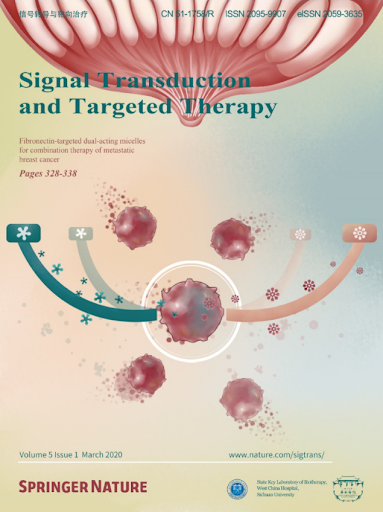Z-DNA-binding protein 1 exacerbates myocardial ischemia‒reperfusion injury by inducing noncanonical cardiomyocyte PANoptosis.
IF 52.7
1区 医学
Q1 BIOCHEMISTRY & MOLECULAR BIOLOGY
引用次数: 0
Abstract
Myocardial ischemia‒reperfusion (I/R) injury is the primary factor that counteracts the beneficial effects of reperfusion therapy. Cardiomyocyte death serves as the fundamental pathological hallmark of I/R injury. However, targeting a single type of cell death has been reported to be ineffective at preventing I/R injury. ZBP1 is well established as a nucleic acid sensor that activates inflammatory and various cell death signaling pathways. However, the specific role of ZBP1 in adult cardiomyocytes, particularly in the absence of nucleic acid ligands, remains largely unexplored. In this study, our dynamic transcriptomic analyses at various I/R stages revealed a cluster of genes significantly enriched in cell death-related processes, with ZBP1 showing significant expression changes in both our I/R injury mouse model and public human ischemic cardiomyopathy datasets. Cardiomyocytes are the primary cell type expressing ZBP1 in response to I/R injury. Hypoxia/reoxygenation stress induced the upregulation of multiple cell death markers indicative of PANoptosis in adult cardiomyocytes, which was mitigated by ZBP1 deficiency. Compared with treatment with conventional cell death inhibitors, cardiomyocyte-specific Zbp1 deficiency ameliorated I/R-induced PANoptosis, resulting in a more substantial reduction in myocardial infarct size. Conversely, myocardial Zbp1 overexpression in adult mice directly induced cardiac remodeling and heart failure. Mechanistically, ZBP1 drives cardiomyocyte PANoptosis by promoting the formation of the ZBP1/RIPK3/CAS8/CAS6 PANoptosome complex. Virtual screening and experimental validation revealed a novel small-molecule compound, MSB, which has high binding affinity for ZBP1 and effectively attenuates myocardial I/R injury both in vitro and in vivo. Collectively, these findings highlight the role of ZBP1 as a mediator of cardiomyocyte PANoptosis and suggest that targeting ZBP1 could be a promising strategy for mitigating myocardial I/R injury.z - dna结合蛋白1通过诱导非典型心肌细胞PANoptosis加重心肌缺血再灌注损伤。
心肌缺血-再灌注(I/R)损伤是影响再灌注治疗效果的主要因素。心肌细胞死亡是I/R损伤的基本病理标志。然而,据报道,针对单一类型的细胞死亡对预防I/R损伤无效。ZBP1是一种核酸传感器,可以激活炎症和各种细胞死亡信号通路。然而,ZBP1在成人心肌细胞中的具体作用,特别是在缺乏核酸配体的情况下,在很大程度上仍未被探索。在这项研究中,我们在不同I/R阶段的动态转录组学分析揭示了一组在细胞死亡相关过程中显著富集的基因,其中ZBP1在我们的I/R损伤小鼠模型和公开的人类缺血性心肌病数据集中都显示出显著的表达变化。心肌细胞是I/R损伤反应中表达ZBP1的主要细胞类型。缺氧/再氧化应激诱导成人心肌细胞中指示PANoptosis的多种细胞死亡标志物上调,而ZBP1缺乏可减轻这种上调。与传统的细胞死亡抑制剂治疗相比,心肌细胞特异性Zbp1缺乏改善了I/ r诱导的PANoptosis,导致心肌梗死面积更大幅度的减少。相反,成年小鼠心肌Zbp1过表达直接诱导心脏重构和心力衰竭。在机制上,ZBP1通过促进ZBP1/RIPK3/CAS8/CAS6 PANoptosome复合物的形成来驱动心肌细胞PANoptosis。虚拟筛选和实验验证发现了一种新型小分子化合物MSB,该化合物对ZBP1具有高结合亲和力,在体外和体内均能有效减轻心肌I/R损伤。总的来说,这些发现强调了ZBP1作为心肌细胞PANoptosis的介质的作用,并表明靶向ZBP1可能是减轻心肌I/R损伤的一种有希望的策略。
本文章由计算机程序翻译,如有差异,请以英文原文为准。
求助全文
约1分钟内获得全文
求助全文
来源期刊

Signal Transduction and Targeted Therapy
Biochemistry, Genetics and Molecular Biology-Genetics
CiteScore
44.50
自引率
1.50%
发文量
384
审稿时长
5 weeks
期刊介绍:
Signal Transduction and Targeted Therapy is an open access journal that focuses on timely publication of cutting-edge discoveries and advancements in basic science and clinical research related to signal transduction and targeted therapy.
Scope: The journal covers research on major human diseases, including, but not limited to:
Cancer,Cardiovascular diseases,Autoimmune diseases,Nervous system diseases.
 求助内容:
求助内容: 应助结果提醒方式:
应助结果提醒方式:


